Bit of a rush towards the end, but we made it! Just about.....
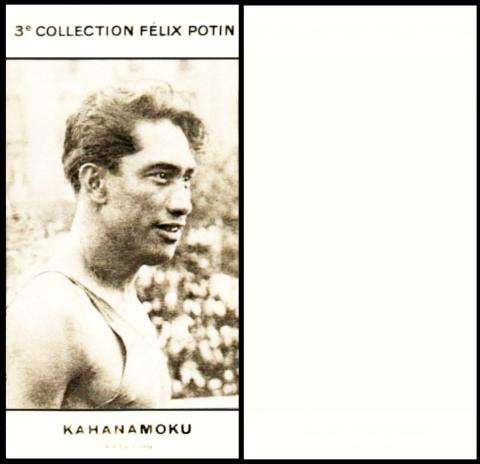
Felix POTIN [trade : chocolate : O/S - Paris, France] "Celebrities" - third series (1922) Un/510
Let us start, then, with a centenary, not of this man`s birth, but of a heroic act in which he saved several people from a shipwreck.
Here it simply calls him "Kahanamoku", but he was born Duke Paoa Kahinu Mokoe Hulikohola Kahanamoku, on August the 24th, 1890, in Honolulu, Hawaii. Duke was his father`s name, and his family were native Hawaiians.
He is chiefly remembered today for being a swimmer, (winning five Olympic gold medals), surfer, and a lifeguard. He was also the first person to be inducted into both the Swimming and the Surfing Halls of Fame. Most of all, he really ought to be credited with popularising the sport of surfing, which, until he started giving exhibitions, was a sport almost unheard of outside Hawaii, and it is also true that he introduced it to both America, in 1912, and Australia, in 1914.
However the reason he is here today is that on June 14th, 1925, he rescued eight men from a boat that capsized near Newport Beach Harbour, in Calfornia. He did this by using his surfboard, surfing out, grabbing a fisherman, and paddling back in. Seeing what he was doing, two other surfers joined in. But sadly five men were still lost to the waves.
You can read more about the incident at eos.surf/Kahanamoku.
Another thing we have him to thank for is that this rescue led to the surfboard being seen as not just a pastime, but a method of life saving. And that is why beach lifeguards have them to this day.
He died of a heart attack on January 22, 1968, aged seventy-seven, and requested to be buried at sea. This was obeyed, at Waikiki Beach, though he was actually cremated, and the ashes scattered to the ocean.
It is generally regarded that his "Rookie" card is the 1913 Pan Handle Scrap "World`s Champion Athletes".
Our card is slightly later, but seems to be much less known. Actually this card is cut down, it is supposed to have black borders to the front - so if anyone has an uncut card do let us know. And that is something to bear in mind if you see any of the other cards being offered at a bargain rate, especially the "prize" of the set, Jack Dempsey.
At this point we ought to say that Mr. Felix Potin was long gone by the time these photographic cards were circulated; he died in 1871. And though there is no proof as to when the cards were printed, looking at the people on them gives us a range for the first series, of approximately 1898 - 1908. We are a bit more knowledgeable with the other series, believing that Series two was issued very soon after the end of Series one, in 1908, with a gap, perhaps due to the First World War, before the third series in 1922, and a much longer gap until the last, fourth series, in 1952.
We know that most of the photographs for this third series were taken by Henri Manuel, who was the official photographer of the French government from 1914 to 1944. Not sure if this card was one of his yet though.
And, by the way, the hardly visible word in the bottom border of this card, beneath the name, is "Natation", which is French for "swimming".
There are actually three swimmers included, the other two being Georges Pouilley (1893–1958, three time winner of the Christmas Cup International Race which was actually swum in the River Seine on Christmas Day) and Mademoiselle Suzanne Wurtz (1900-1982, who later became a film actress). Both of these competed at the 1920 Olympics, but neither won any medals.
Since writing this, I have been told that you can see all the cards at Pre War Cards/Potin3 - and there are links to similar pages of the other series on the same site.

Chocolat Carpentier [ trade : chocolate : O/S - France] "Sports"? [1897] Un/?
Another sporting tale now, of the first American woman to win an Olympic event, without ever realising she had.
Her name was Margaret Ives Abbott, and she had been born in 1878 in Calcutta, India, where her father was a prosperous merchant.
Sadly though, when she was young, he died, and she had to move to America, starting in Boston, then going to Chicago. The relocation was through her mother`s work, she was also an unusual lady, a literary editor for a newspaper, the Chicago Herald.
During this time, she took up golf. Now at the time that was not an unusual sport for a woman, in fact doctors recommended it, but a lot of men were still not so keen on allowing them to play, and few clubs would permit them as members, though, grudgingly, they were sometimes allowed to play as long as it was a doubles match, each lady teamed with a man.
When she was a bit older, she went to Paris, on a kind of Grand Tour, to study art. She left America, with her mother as chaperone, when she was twenty-one, and stayed for three years, and in her second year Paris hosted the Olympic Games. This is where it gets confusing, as at the same time there was a huge exhibition, the 1900 Paris Exposition.
Now the Olympics were only for men, but women were, in that year, allowed to compete in some events - golf, horse riding, rowing, sailing, and tennis. And other sports contests for women formed part of the Exposition.
So Miss Abbott and her mother both entered one of the contests, to be played over nine holes, at a golf club not so far from Paris. They thought it would be a bit a fun.
On the day, Miss Abbott was well in form, and won, with a forty-seven. Her mother was not so lucky, and came home tie seventh, with a score of sixty-five. Her prize was a porcelain bowl, which she carried back to America as a little souvenir.
In 1902 she married, and moved to New York. She continued to play golf there, and the couple had four children. She died in 1955.
It was not until Professor Paula Welch of the University of Florida stumbled on the story, and started researching, that the truth came out. And that was that the golf tournament was indeed not only part of the Olympics, but it meant that Miss Abbott had been the first ever female Olympic winner.
And I sit here, wondering, where that bowl is now....
As for the set, we know a few cards, which are :
| L`Auto | - [Motor Racing - male and female] |
| La Canotage | - [Rowing - female] |
| Les Courses a Pied | - [Running - two males] |
| L`Escrime | - [Fencing - male] |
| Le Foot-Ball | - [Football - male] |
| Le Golf | - [Golf - female] |
| Le Natation | - [Swimming] |
| Le Patinage | - [Ice Skating - male and female] |
If anyone knows any other sports featured, do let us know.
By the way, there is a small circle on each card with the number 88 in it, but this is not the number of the card, it appears on all the cards so far known.
It could be the series number, as some collectors have suggested, but so far we know of hardly any sets issued by this manufacturer, and so this seems improbable.
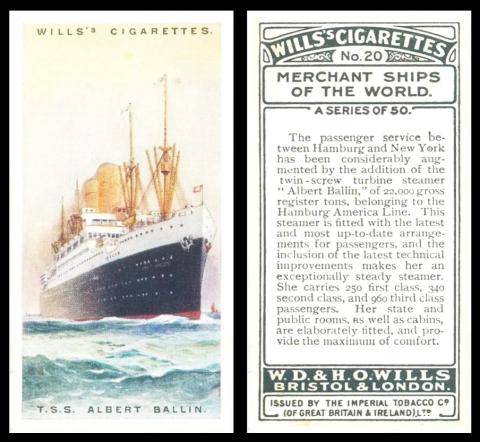
W.D. & H.O. WILLS [tobacco : UK - Bristol] "Merchant Ships of the World" (October 1924) 20/50 - W675-196 : W62-157 : RB.21/200-257.A : W/257.A
Forward now, for another centenary, this being of the founding of the International Mercantile Marine Officers Association, today in 1925.
And before I continue, yes I have used this set already. But I failed to find any other cards for the Mercantile Marine. If anyone has anything, let us know!
Now the story of the Mercantile Marine - which just means shipping done for trade purposes, not war, or travel - starts a long way back, almost as soon as a sailor complained about their job, or, more correctly, their conditions of living and working.
The first real national cause for complaint came in 1849, when the current requirements, for British vessels to have a maximum of one quarter non-British crew, were abolished. Sailors knew that this would see cheap, Foreign labour drafted in, and their jobs would be on the line.
The first actual maritime union, though, was The National Amalgamated Sailors' and Firemen's Union, founded in Sunderland, in 1887, and becoming a national union not long after. This only covered men at sea - so in 1896 along came the International Federation of Ship, Dock and River Workers, which soon became the International Transport Workers’ Federation.
In 1919, just after the end of the First World War, lots of laws were being made, and many new rights for workers. And so was founded the International Labour Organization, which included seafarers as part of its target audience. It was actually one of the first groups to realise that men at sea were workers, just like men who went to work in offices, and shops.
Yet it was not until 1928 that basic rules were laid down - the guarantee of employment for seamen; a minimum age for children to work at sea; and payments to sailors after the loss of their vessel.
Much of this was due to the International Mercantile Marine Officers' Association, founded today in 1925. However that meeting, and the organisation, was really only for overseas sailors, from America, Belgium, Denmark, France, Germany, the Netherlands, Norway, and Spain.
It was not until 1940, with their headquarters forced to relocate to London, that the two scions grew closer together. And, in 1946, they agreed to merge - though this did not take place until 1965.
So it turns out that this card is pretty special; as revealed by its first listing, in our original Wills booklet, part IV (RB.16, published in 1950). That entry reads ;
- 257. MERCHANT SHIPS OF THE WORLD. Fronts printed by letterpress in colour. Backs in grey, with descriptive text.
HOME ISSUE, 1924
A. Series of 50. Wills` name and I.T.C. Clause at base of back.
NEW ZEALAND ISSUE, between 1925-30
B. Series of 50. Wills` name only at base of back. Numbering differs from A at Nos. 5-20; card No.4 "T.S.S. Letitia" replaces "T.S.S. Albert Ballin" - No.20 in A
GENERAL OVERSEAS ISSUES, between 1925-30
C. Series of 50. No framelines to backs. Numbering as B. Anonymous issue.
Because it has an overseas connection, that always merits a look at RB.21, the British American Tobacco booklet, and that brings us a lot more information, for it reads :
- 200-257. MERCHANT SHIPS OF THE WORLD. The recordings in W/257 and RB.9/68 are summarised and amended below :-
- A. Wills` Home Issue. Series of 50.
- B. Wills` Overseas Issue. Series of 50.
- C. Anonymous Issue, with letterpress to back.
- 1. Series of 50. No framelines to back
- 2. Series of 25. Framelines top and bottom of back.
- D. Lambert & Butler overseas issue. Series of 50.
- E. I.T.C. of Canada issue. Serial 8081. Series of 50
- F. U.T.C. issue. Series of 50
- G. Albert issue. Size 71 x 50 m/m, pictures same size as in other printings, words "Cigarettes Albert" added in red in deep margin above picture. Series of 50, titled "Les Grands Paquebots du Monde", with descriptive text in French.
Printings B-G differ from A in that numbering varies at Nos. 5-20, and "T.S.S. Letitia" replaces "T.S.S. Albert Ballin" (No. 20 in A).
Now I will not discuss all these here, only our three (or four) sets. For one day I will use one of them as a Card of the Day and make a home page. in our original World Tobacco Issues index,these three are no longer together.
The first two of these sets are in the Wills section. Our home issue is under section 2, covering "Issues with I.T.C. Clause" and sub-section B, for "Issues 1922-39, excluding adhesive backs", entered as ;
- MERCHANT SHIPS OF THE WORLD. Sm. Nd. (50). See RB.21/200-257.A ... W62-157
The New Zealand version is under section 5, for "Other export issues", and sub-section B, "English language issues 1923-30. issued chiefly in New Zealand, some series in Malaya, Malta, and elsewhere". Its the same text as for the home issue, but the codes are different, RB.21/200-257.B and W62-451 respectively.
As for the anonymous General Overseas version, that is now with the "Z" codes at the back of the book, listed as ;
- MERCHANT SHIPS OF THE WORLD. Sm. Nd. ... ZB6-48
(a). "A Series of 50". Back without framelines. See W/257.C
(b). "A Series of 25". Back with framework at top and base. See W/257.D
This is a bit confusing, as W/257 has no D - that only appears in the British American Tobacco booklet - but I imagine the intention was to add it into the Wills book below no.C.
As far as the Wills entries in the updated World Tobacco Issues Index, they are identical to the above, just with new codes - the home issue being W675-196, the New Zealand one being W675-651, and the pair of anonymous issues being ZB07-515.1 and .2. However the confusion is no more, as these two simply cite "See W/257"
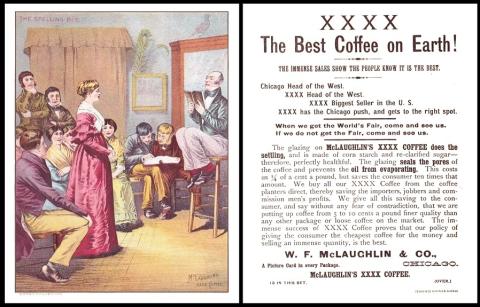
W. F. McLAUGHLIN & Co. [trade : coffee : O/S - Chicago, USA] "?" (1900?) Un/18
Our third centenary of the week is actually proved slightly wrong by this card, so many thanks to Mr. Pryce (after I had despaired of ever finding anything, and started hunting a new subject).
The centenary is often quoted as the first Spelling Bee, but this card proves that not just the idea but the name was known at the time of this card. And it was not, as is often quoted, the first Scripps Spelling Bee, either - they only took over the sponsorship in 1941.
A Spelling Bee, just in case you have never heard of one, is when a group of people, today usually children, take it in turn to spell out a word that is told them by the adjudicator.
In fact the idea of a regional spelling contest had been going for some time, but in 1925 The Courier-Journal, of Louisville, Kentucky, organised a National event, open to American children from any state. And two million entered the regional heats.
Amazingly, Frank Louis Neuhauser, also of Louisville, Kentucky, actually won, on the word Gladiolus. He said that he had grown them so he knew how to spell the word.
He was eleven years old, and the son of a stonemason. And though he would go on to much greater things, he always retained a fondness for the Spelling Bee, and was often seen at regional and national events. He was also in a film, "Spellbound", released in 2002.
The final of the contest was held in Washington, and all the finalists met the President, Calvin Coolidge, before the event began. There was a grand prize too, five hundred dollars, which was awarded in what are said to be "gold pieces".
Our man came home to a grand parade, and was showered by bouquets of gladioli. His schoolmates had also clubbed together to buy him a bike.
When he was older he went to the University of Louisville, and, after graduating with a degree in engineering, was offered a job at General Electrics. He started out as an engineer but they spotted his potential and sent him to college, to study law. He passed those exams too, and in 1940 they employed him as a Patent Lawyer. This did not last too long as he enlisted in the U.S. Navy, during which time the Spelling Bee was cancelled (1942 was the last, and 1946 the next).
General Electric held his job and also arranged for him to have further training so that he could become a Patent Attorney. After that he was put in head of the training programme.
However in 1978 he left, because he had received an offer, from a Washington Law Firm. Whilst there he would rise to chair the Patent Law sections of both the District of Columbia, and the entire American Bar Association, as well as many other legal appointments.
He died in March 2011, aged ninety-seven. And the only other time that the Spelling Bee was cancelled was after that, in 2020, due to covid.
I know much less about this card. It is one of a set of 18, because it says so on the reverse of it but I have not seen any other card in a similar style, which seems to fit, and many of their sets were of 18 too.
The printer, whose name is on the front and back of the card, was Cosack & Co., Buffalo and Chicago. They were founded in 1864, and they were not only printers, they also sold printing equipment.
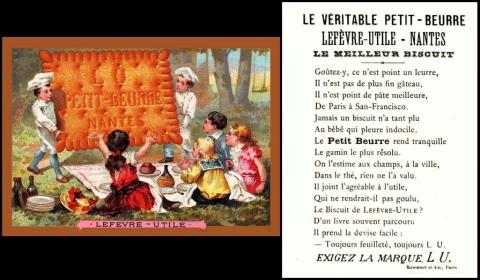
Lefevre-Utile [trade ; [trade : biscuits : O/S - Nantes, France] "Advertisement Card - large biscuit" (1900)
Today is International Picnic Day.
Now I have not been able to find out why that is, but it seems that this time of year, getting towards the middle, and warmer, peoples` fancy turns to relocating their meals out into the open air.
Now they do not abandon the inside completely - there is still a tablecloth, or rug, and cutlery and crockery, albeit plastic, is still the order of the day. The only real difference is that there are no chairs, and there are lots more diners, of the burrowing and biting kind, from the insect world, plus, sometimes, other animals running interference - a passing cow, a loose dog, etc.
Yet we persevere.
The first picnic in literature was in Jane Austen`s "Emma", published in 1815. This was held at Box Hill, after an earlier date had fallen through. And it ends, amusingly, with Emma getting stung.
The word picnic is French, hence our card. As to what it means, it is a combination of two words, pique and nique, separated by a hyphen.
The nique bit means a trifle, but not the type with jelly and custard that ants find so irresistible - it means something light and insubstantial. Which is true of most picnic food, small and not with too much filling....
As for the pique, that has two meanings, either to graze, or take dainty titbits, or to become annoyed and take offence. And I am pretty sure that this happens at many picnics. For it definitely happened at Jane Austen`s literary feast
Now Lefevre-Utile is a new name to this website, but we have featured them before, as the Card of the Day for the 2nd of June 2025 - and that is where you will find a short biography of the company. Our card today seems not to be part of a set, so I have called it an advertising card - but if you have any like it, with different scenes but including a giant biscuit, do please let us know.
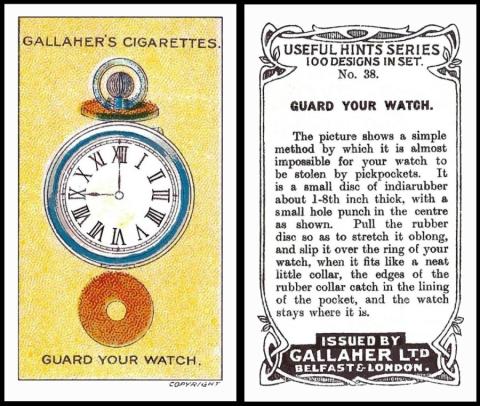
Gallaher Ltd [tobacco : UK - Belfast and London] "Useful Hints Series" (1915) 38/100 -
Now what is the time, I ask myself, as I look at the bottom of my screen, where it appears along the bar. That is all I have, for I do not own a watch. Which may make it rather odd that I have chosen to write about National Watch Day.
We know this was started in 2017 by Nordstrom, who are a clothing and accessories retailer. If you have not heard of them, they have a long story - and it all starts in 1887 when the Swedish John W. Nordstrom got on a ship in Sweden and sailed to America, despite the fact that he had just five American dollars and could only speak Swedish. He took work anywhere he could, even in mines, and slowly travelled to California. In 1897 he went to Alaska, searching gold in the recent strikes, and he must have hit, for he is next heard of in Seattle with almost fifteen thousand dollars - and soon after that, a partner, and a shoe store. Slowly the shop added items to their range, including watches, retailing the finest of brands, and today they are retailing worldwide, online.
But the story of the watch is a longer one than that, much longer.
The earliest watch was made in Nurnberg, Germany, in 1505, by Peter Henlen. However he was but a link in a chain, for the area was full of people making miniatures and toys, reducing them ever smaller. And his watch also relied on better materials and stronger - which allowed for the making of a smaller mainspring, the life force of a watch, the thing that winds up and ticks down.
These watches were worn, on chains, like jewellery. They were copied by lesser makers, until some of them were hardly functional as watches, but all were elaborate on the outside, as pendants.
These went on until the seventeenth century, when suddenly fashion decreed that watches on chains were no longer "in". Instead, those in the know wore their watches out of sight, in a pocket inside their clothes. Hence pocket watches. And the only change to those came when Prince Albert, future husband of Queen Victoria, was seen to pull his watch out of his pocket by using a chain, attached to both watch and clothing.
As for the final change, that came in the First World War, when soldiers, and particularly airmen, did not have time to fossick in their pockets and find their watches. Then one day, someone had the brilliant idea of fixing their pocket watch to a strap for their arm. And so we gained the wrist watch.
However there are wrist watches from earlier. And they were made by familiar names who you may not realise have such a lengthy line. The first was reportedly made in 1868 for a Hungarian Countess by a Swiss watchmaker called Patek Philippe. This contradicts another claimant though, Abraham Louis Breguet, whose wrist watch was made for the Queen of Naples, in 1810.
This set first appears in our Gallaher reference book, RB.4, published in 1944, as ;
- 1915. 100. USEFUL HINTS SERIES. (titled series). inscribed "100 designs in set". Size 2 1/2" x 1 1/2". Numbered 1-100. Fronts lithographed in full colours, marginal lines and white margins. "Gallaher`s Cigarettes" in block letters and subjects titled. Backs printed in black with descriptions and "Issued by Gallaher Ltd., Belfast & London."
- 100 USEFUL HINTS SERIES. (titled series). Similar to the above but backs printed in very dark brown instead of black.
oddly, by the time of our original World Tobacco Issues Index, approximately ten years later, that second version is no more - the entry simply reads ;
- USEFUL HINTS SERIES. Sm. Nd. (100) ... G12-27
And it is not restored in the updated version of this volume either, the text above is exactly the same, save, of course, for a new card code, of G075-220
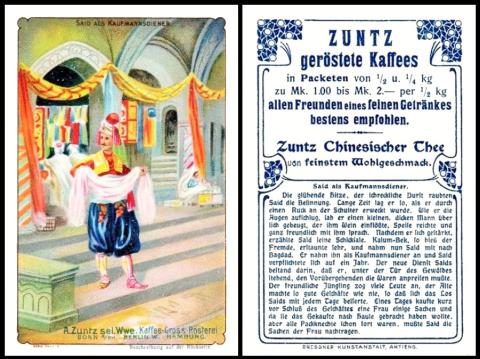
A. ZUNTZ sel. Wwe [trade : coffee and tea : O/S - Germany] "Tausendundeine Nacht" / "The Arabian Nights"
Today, in 1991, saw the decision made to relocate the newly reunified German Capital from Bonn back to Berlin.
This is maybe not the most fitting card, but it tells an interesting tale, as it was issued by a company with branches in Bonn and Berlin.
And that company was also run by a woman, Rechel, or Rachel Zuntz, born in 1787.
There is something else important on this card too, small as it is, for the name of the company is A. Zuntz sel. Wwe. And the "WWe" is an abbreviation for witwe - or widow.
She had a family connection with selling, as her father, a native of Bonn, but of Jewish blood, had run a grocery store as well as selling and brewing coffee. Her husband, Amschel, who was also her cousin, was older than her, by nine years, and he died in 1814, four months before she gave birth to their first and only child, Leopold. She then returned to her parents, and took over her father`s company when he died in 1837.
At that time, it was just Rechel, the widow, and her son, and, as she aged, her son slowly took over.
She was not too happy about this and there was friction with his wife, also he had a lot of children (five sons and six daughters) which she felt distracting to the business. It seems that she stayed at the helm for far longer than he would have liked, until her death, in 1874.
Strangely, Leopold died the very same year, and his son, Albert, was able to take over with a more or less free hand. It was under him that the branch in Berlin was opened, fairly quickly after, in 1879, something which would have pleased his grandmother immensely, as it had always been her dream to have a shop there. But not long after, in 1881, he too was dead, of what is thought to have been tuberculosis; so he never got to see his dream, of a shop in Hamburg. This was only fulfilled by his brother, Josef, who also managed to have their blend declared the official coffee for several members of the Imperial German court. And he also expanded into coffee houses, where you could both sit and pay to drink the coffee, and buy a pack to take to drink at home.
After the First World War, none of Leopold`s children were left alive; some had died through old age and disease survived, some had been killed in the conflict. The business therefore passed to his grandchildren, August and Albert - one of whom was in charge of the Berlin branch and one of whom the Bonn one. This is probably contemporary to our card.
They also introduced the familiar trademark, of an elderly lady, based on one of the few pictures of Rechel.
The inter-war years were probably their greatest and most successful time, but ended in disaster, with the business being forcibly taken over, and the closure of the Berlin works, even though the company allowed a third partner in 1933, who was a more fitting figurehead to the current German regime.
After the war, with much of the family and their story lost, things slowly rebuilt. The Berlin branch was taken over by another coffee company, called Dallmayr, who bought the entire company in 1976, though, and pleasingly, they still make "The Blessed Widow" brand in honour of Rechel
There are others of this set, but it would take too long to hunt tonight. However it is a project for the future.
This week's Cards of the Day...
joining Royal Mail, whose latest issue of commemorative stamps celebrate the three hundred and fiftieth anniversary of the Royal Observatory in Greenwich, which they call "the home of modern British Astronomy".
This time their first class stamps have returned to being long thin ones, rather than the usual squarer format.
They cover the completion of Flamsteed House in 1676, the observation of the Meridian in 1851, the first public clock in 1852, Greenwich being chosen as the centre of Time and Longitude in 1884, the Great Equatorial Telescope of 1893, and the Annie Maunder Astrographic Telescope of 2018.
Then there is a miniature sheet of four of the usual squarer stamps, which trace the development of John Harrison`s Marine Timekeepers H1, H2, H3, and H4.
Saturday, 7th June 2025

This clue was rather a teaser, as it shows Charlton Athletic, and that is the closest football league team to Greenwich. But disregard the popular notion that at one time the team was in an entirely different county, of Kent; for though the area may indeed have only become part of London in 1855, the team was not founded until 1905. And, curiously, we know the date of that founding, which was the 9th of June - the day I typed these words on the reveal for the theme of the week.
Here we have a very sought after, and scarce set. And yes, they are hand-coloured, but do not let that put you off, as they are really well done. The only real problem with them is the size, which is quite large indeed.
Now for some reason these were originally listed in our British Trade Indexes under "Topical Times", with a header, (at least in BTI part one), that read "Periodical. Cards issued about 1925-40. Most series are very large size and outside the scope of this volume. See C.N.N., Vol 20, pages 15/20 and 60, which also cover subjects in two series listed under Set TOA-1. For Anonymous issues, see sets ZB7-11 and ZB7-12".
None of the sets listed in this volume, or part two, are ours. For these, you have to wait until part three, where the header tells you to "Delete set TOA-1 in I, series relisted below with other larger size card issues". And what`s more, our set turns out to be in two parts :
- Footballers - Coloured (A). 250 x 94. Issued 1936. ... TOA-14
1. English Players. (16)
1. Jack . Atkinson. Bolton Wanderers F.C.
2. Robert Baxter, Middlesbrough F.C.
3. Harry Betmead, Grimsby Town F.C.
4. Len Butt, Huddersfield Town F.C.
5. W.J. Crayston, Arsenal F.C.
6. W. Dale, Manchester City F.C.
7. Jock (Ephraim) Dodds, Sheffield United F.C.
8. Alec Hastings, Sunderland F.C.
9. Harold Hobbis, Charlton Ath. F.C.
10. C. Wilson-Jones, Birmingham F.C.
11. James Mercer, Everton F.C.
12. J. Nicholas, Derby County F.C.
13. Clifford Parker, Portsmouth F.C.
14. Frank Soo, Stoke City F.C.
15. Bert Sproston, Leeds United F.C.
16. Vic Woodley, Chelsea F.C.
2. Scottish Players (16)
1. Robert Beattie, Kilmarnock F.C.
2. Andrew Black, Hearts F.C.
3. Thomas Brady, Hibernian F.C.
4. Hutton Bremner, Motherwell F.C.
5. William J. Bruce, Albion Rovers F.C.
6. Stewart Calderwell, Partick Thistle F.C.
7. Jimmy Denmark, Third Lanark F.C.
8. J. Eric Guthrie, Dundee F.C.
9. Robert Harrison Hammilton Acas. F.C.
10. John Lowe, Arbroath F.C.
11. Willie Lyon, Celtic F.C.
12. W. Martin, Queen`s Park F.C.
13. Patrick Mc Camon, St, Mirren F.C.
14. Thomas Mooney, Airdrie F.C.
15. R, Shankly, Falkirk F.C.
16. George Thomson, Aberdeen F.C.
Note : An album was issued, titled "Topical Times -Panel Portraits Album of Star Footballers" with blank spaces for 48 cards. No biographies.
The only change to this in part four is a correction, namely :
- TOA14-2 (Footballers 1936- Scottish Players). 16 listed on page 306 of III.
Correct No.6 to Stewart Calderwood, not Calderwell
Sunday, 8th June 2025

This card gives us the very beginning of our story, for it was this man, Charles II, who appointed John Flamsteed as Royal Observator to The King on March the 4th 1675.
And also he who decreed on the 22nd of June in that same year that "... in order to the finding out of the longitude of places for perfecting navigation and astronomy, we have resolved to build a small Observatory within our Park at Greenwich upon the highest ground … with lodging rooms for our Astronomical Observator and his Assistant."
However this did not begin construction until the 10th of August.
This set first appears in our first ever original reference book, RB.1, published in 1942, where it is described as :
- 1902 (about)
40. KINGS AND QUEENS (untitled series). Size 2 3/4" x 1 1/2", Unnumbered. Fronts, lithographed in full colour, name and dates in a shield. Backs printed in chocolate brown, no descriptions. "W. & F. Faulkner Ltd." Probably issued in connection with the Coronation of Edward VII. Similar to Singleton & Cole. Subjects numbered here, and arranged in datal order.
Now since the list in that book is so well done, I will try to scan it and paste it in here later, despite the fact that it is over two pages.
The Singleton & Cole mention is intriguing, for the fronts of that set seem the same as ours, though I have not tracked down their Charles II.
Now when I wrote this I noted that in our original World Tobacco Issues Index their set was issued in two formats, with different sized lettering in the shield - either 1 m/m or two m/m - and I said that I was not sure if this may also apply to our set and nobody has ever noticed it before.
However, when I got to the listing of our set in our original World Tobacco Issues Index, I found that reads :
- KINGS & QUEENS (A) Sm. 68 x 38. Unnd. (40). See H.157 and Ha.157 ... F14-26
A. Small lettering in caption shield, names about 1 m/m high
B. Larger lettering in caption shield, names nearly 2 m/m high.
So that difference must have only been noted in the years between 1942 and 1956, and I may, therefore, be able to track down the original discovery in contemporary magazines. Once I have, I will add it here.
Sadly, with space at a premium for our updated World Tobacco Issues Index, the listing is very truncated, to just :
- KINGS & QUEENS (A) Sm. 68 x 38. Unnd. (40). See H.157 ... F150-550
But tomorrow I will hit the handbooks and see what they reveal.....
Monday, 9th June 2025
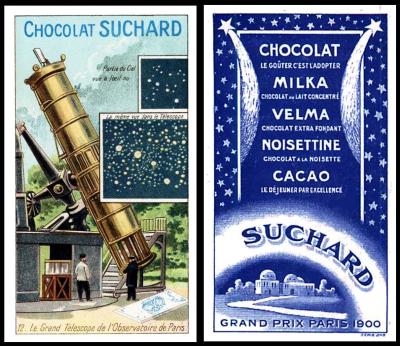
This is a bit of a tangent, as it shows the Paris Observatory, but there is a rather intriguing link, as the Paris one came first - it was suggested in 1667 and built by the early 1670s. So perhaps the need for a British Astronomer Royal came more from royal chit chat, and a desire to copy the French, than from Charles II`s sudden interest in astronomy.
You can find this set with a very blue back, like our card, or with a grey one, as you can see with our Card of the Day for the 21st of August 2025. Some collectors think that the blue of our version has simply faded to grey, but I do not think so now I have seen the grey, this blue is so very deep and striking; I think it would need something akin to bleach to render it that grey, and then you would not get such an even fading.
It seems more likely that the set was issued twice - and that could also explain the fact that the date seems to always be quoted as 1900 - 1910, as perhaps one of these versions was issued in 1900 and the other in 1910, and what was at first recorded as two separate years has been replaced by a hyphen linking a decade together.
The set consists of twelve cards, which are :
- La Comete
- Les Saisons - Le Solstice d`Ete
- Eclatement d`un Bolide
- La Fata Morgana (Mirage)
- L`Aurore Boreale
- L`Eclipse de Lune
- Les Phases de la Lune
- Les Saisons - Solstice d`Hiver
- Le Systeme Planetaire
- Eclipse Totale de Soleil
- L`Etoile Polaire
- Le Grand Telescope de l`Observatoire de Paris
Tuesday, 10th June 2025
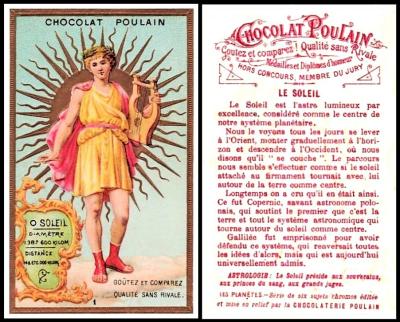
Now today most astronomy is concerned with the moon and the stars, things we see at night. But when the Royal Observatory was founded, it was mainly concerned with tracking the sun, in daylight.
At night, yes, there were the stars, but most short journeys were very much hoped to be accomplished within the sunlit hours.
As an island, we knew the importance of sailing, for trade, and for exploration. And though, at first, when we paddled out on our rudimentary boats, it was not important where we went, only that we went, later on sailors wanted to plot an accurate course, which would allow them to find the land they sought, or to tack round and surprise an enemy at war.
Some of this information was based on the tides, which are fairly regular, until the sum and the moon form certain angles in the sky, and then they give us extra low and extra high tides. The sun was also important though because it was so visible, and as it moved across the sky throughout the journey, slowly, from one side to the other, it was like a torch that shone the route, with the shadows slowly changing in height and in position as the sun changed ends.
This set is of six cards, each one a planet. The figure is based on classical mythology, and in the shield are its diameter, distance from the Earth, and how long it takes to go completely round the sun before returning to where it began. This last figure is not on our card, as it is the sun.
The planets are :
- Le Soleil - The Sun
- La Lune - The Moon
- Jupiter - Jupiter
- Venus - Venus
- Mercure - Mercury
- Mars - Mars
They are actually embossed around the figure, and this is visible on both sides, but does not now show up so well on this picture. It may, therefore, be redone.
The only thing I do not know is the date. Do you?
Wednesday, 11th June 2025

So today we have a very important part of the Royal Observatory that few people seem to know about, and that is the large red ball on the pole atop the tower.
The tower is actually part of Flamsteed House, and the ball was one of the first public time signals, though when it began, in 1833, it was only intended to tell the time to ships as they travelled along the Thames.
To us, today, it seems quite ineffective, as it only performs three functions and only once a day. These are at 12.55 p.m., when the ball rises up the pole and stops about half way up - at 12.58 p.m., when it goes all the way to the top - and then at 1 p.m., when it falls down the pole to the bottom again. But at that time, when its function became general knowledge, it became quite a thing for the general public to go and watch it rise and fall, and also the whole operation took but five minutes. It soon attracted crowds, and many of the locals would set their own clocks by the rise and fall of the ball.
At that time, too, the hour was constant. Today the clock operates two schedules at 1 p.m. Greenwich Mean Time in the winter, and at 1 p.m. British Summer Time in the summer. And, owing to its age and the fragility of its inner workings, it neither rises nor falls during wind or other inclement weather.
These cards often come up in mixed lots of odd cards and we are often asked about them by members of the general public.
Fax Pax is a way of saying that the cards contain lots of facts (fax) and, like playing cards, come as complete sets (or packs / pax) in boxes. They were not available as odds, and I do not think that any dealers at the moment sell them in that way either, but if anyone does do let us know.
The company was founded in the mid 1980s by Jeremy Brown and Ashley Mickelright in Falmouth, Cornwall, UK. They produced the following sets :
- 1985 - Kings and Queens (40)
- 1986 - Golf (36)
- 1987 - Tennis (38)
- 1988 - ABC and Numbers (36)
- - Fables (36)
- - Historic Houses (40)
- 1989 - Cathedrals, Abbeys and Minsters (40)
- Football Greats (36) - which includes George Best and Pele
- Football Stars (36)
- Forty Great Britons (40)
- 1990 - Scotland`s Heritage (40)
- 1991 - Britain`s Royal Heritage (40)
- 1992 - London (40)
- 1993 - Famous Golfers (40)
- World of Sport (40)
- 1995 - Modern Rhymes (40)
- Nursery Rhymes (40)
- 1996 - Wild Flowers of the British Isles (50)
Many collectors swear that the ABC and numbers cards came first and gave the idea for the rest, whilst others will tell you that the packs of thirty-six cards came first and then the forties and fifties. However our table of issue dates proves both those facts to be wrong.
There are also two sets I have not managed to date, these are "Castles", and "The Old West From A-Z"
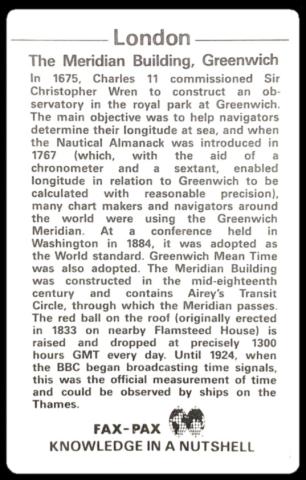
Now there is a connection that I have not been able to unravel yet, this is concerning another company, Flash-Pack Cards, Inc. which is an American company supposedly set up entirely to produce three sets, "Presidents of the United States of America - George Washington to Bill Clinton", a companion set of their "First Ladies", and "The American West" (1992). Possibly this is the "Old West" set mentioned above ?
They had a catch phrase of "Knowledge in a Nutshell", but the packs I have seen so far quote the name of Fax-Pax USA. Inc., and two different phone numbers but both of these have the area code for Connecticut.
Now since I wrote this a reader has supplied this card, the same as ours, with all the same information as text, but in vertical format, and it also says "Knowledge in a Nutshell". But where this fits in I have no idea. Do you?
Thursday, 12th June 2025
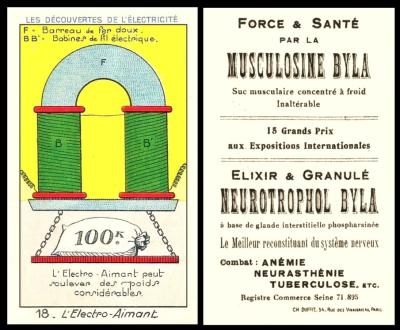
Now this card explores a facet of the Greenwich Observatory that I had never heard of before - and that is that in 1816, the Astronomer Royal (who was, at that time, John Pond), was ordered by the Admiralty to start making magnetic observations, in other words to begin to measure a specific angle that covers a great circle passing through the North and South Pole.
To do this, he needed a special Magnet House, with a long, deep-sunk thermometer and a mast, eighty foot into the sky, which served as the electrometer. This did not last very long, as the house started to sink into the ground, and by 1824 it was demolished.
Curiously, it was not long after this, in 1831, that Sir James Clark Ross announced that he had discovered the location of the North Magnetic Pole, in northern Canada.
What seems unclear is why all of a sudden we started to investigate such a thing.
Anyway in 1835, John Pond left, and he died the following year. His post was taken by George Airy, who was most keen on continuing the research into the magnetic anomalies around the poles, and managed to make the Admiralty build him a purpose built Magnetic Observatory, of wood on a concrete base - simply because iron and brick, etc, can affect magnetic fields and confuse research. He also asked for more, and specialised staff, plus a larger area of ground surrounding the observatory. All this was allowed, though the land does not seem to ever have been used, only fenced off to stop passers by coming too close.
The new Airy's Magnetic Observatory was built by May 1838.
It no longer exists, and nothing can be seen; it is completely covered by the Peter Harrison Planetarium, which is a digital laser planetarium, with seating for a hundred and twenty.
As for magnetic observations, they have not stopped, but they are now conducted at observatories in Eskdalemuir (Dumfries and Galloway), Hartland (Devon) and Lerwick (Shetland Isles).
I thought "Byla" was a brand, but it turns out to be a person, Pierre Byla, who wrote several books on medicine in the early 20th Century. And he is proving elusive.
The company also issued several sets of trade cards, including very attractive ones on costume and peoples of the world - which we will show you in the future.
Our set relates to magnets, but to electromagnets - where a wire is wound into a coil and a magnetic field, along the centre of the coil, is produced by the electric current.
The whole set relates to electricity, and I thought at first that it was alike to the Guerin Boutron set, but it is not, and I cannot find any other issuer of this.
The cards I know of so far are :
- Principe du Telegraph
- Manipulateur Morse
- Recepteur Morse
- Principe du Telephone
- Transmetteur (Telephone de Bell)
- Le Pile Lelanche (P.T.T.)
- Lampe electrique a filament ou a incandescence
- Lampe a Arc
- Tramway Electrique
- Accumulateurs (pour Autos)
- Telephone Domestique (Conversation)
- Transformateur
- Rayons X (ou Rontgen)
- L`Epreuve photo d`un bras
- L` Electro Aimant
- La T.S.F. (Principe)
- T.S.F. (Le Detecteur Electrolytique)
- T.S.F. Poste Recepteur
- Le Cable Telegraphique Sous-Marin
- Radioconducteur de Branly
- La T.S.F. (Croix d`Hins)
- La T.S.F. Sauveteuse - [the SOS distress signal]
But if you know any others, do please let us know!
Friday, 13th June 2025
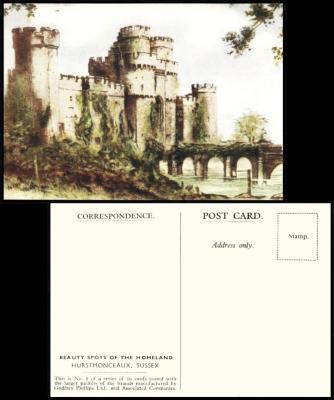
This card tells almost the final chapter in the Royal Observatory, but it starts with three bombs.
The first one was detonated by an anarchist in February 1894. You can read a fictionalised account in Joseph Conrad`s "The Secret Agent", published in 1907, fictionalised because the bomber was killed by his own bomb and it seems impossible, even. to find out why he was there. He certainly did not have time to tell his tale before he died. The only thing we do know is that he was a member of Club Autonomie, which is said simply to have been a meeting place for anarchists.
The second and third bombs came during the Second World War, in 1940, though the target was really the docks, nearby. In that attack, the Altazimuth Pavilion, and the Great Equatorial Building were damaged. Then, in 1944, the great Onion Dome was hit by a flying bomb.
It was decided that the collection and the workings of the Observatory could no longer stay in London at that point. There had been earlier plans to move, citing the smoke in London which often led to important viewings being obscured, and, as we find today, artificial street lighting is not helpful to astronomers. The magnetic work had already gone, disrupted by the arrival of the Underground Tube Lines, that had moved to Abinger, near Dorking. And just before the outbreak of the Second World War these plans had been re-drafted.
In 1944 it was decided to relocate to Herstmonceux Castle, the subject of today`s card, but it was not announced, or enacted until 1946, seemingly because running from London may cause a panic in the general public. Though it seems likely that a lot of the works had stopped and the equipment been sent into storage.
The Royal Greenwich Observatory, Herstmonceux, was a rather lengthy title, and the last word was soon omitted. It took until 1958 for everything to be in place there, but it did not last for long, The weather was already changing, and in the late 1970s the decision was made to relocate the main Isaac Newton Telescope overseas, where visibility was better. Overseas, was on Las Palmas, one of the Canary Islands.
This led to another decision, to move the rest of the facilities to Cambridge. And that happened in 1990. Today the Greenwich buildings are but a showcase, and a learning centre, with many family attractions and displays which, in simplified form, tell snippets from the story of its past.
Hectic week, and next week will be worse. Over the weekend, all the gen from the reference books, and the codes, will be added, along with anything I hurried in order to finish.
The duplicated United Tobacco Companies medal card will also be sorted out, and maybe even an uncut Potin card will surface.
Anything that gets added in will be advertised as part of the banner on the main page, with a link back to here, being replaced as the next day down is completed
Its raining and I am off to turn in. And I was going to an outdoor book sale tomorrow. Not sure I am now....
